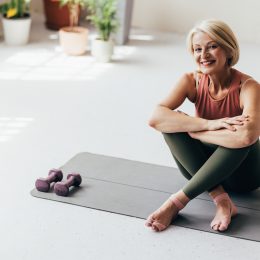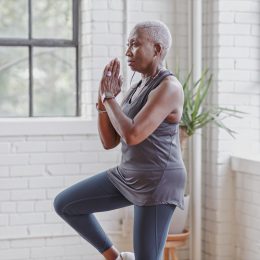The 11-Minute Total-Body Booster
All you need is your body and a little bit of floor space for this strength and cardio plan.
Tip: You can adjust the speed or quality of the video by selecting the Settings (gear) icon in the bottom-right corner of the video.
You don’t need a lot of time, space, or equipment to fit in an effective total-body workout. But you do need a plan. And that’s exactly what you’ll get in this quick video with fitness expert David Jack: four smart exercises that use only your bodyweight as resistance.
These do-anywhere moves work multiple muscle groups at once while also keeping your heart rate up, so you get both strength and cardio benefits. Plus, you can easily modify any of the exercises to your current fitness level. “This is a quick, effective, safe, and accessible workout that you can make more challenging if you want to,” Jack says.
How the Total-Body Booster Works
Do each exercise in order for 40 seconds, resting in between as needed. After the final exercise, the single-single-double jumping jack, rest one to two minutes, and then repeat the full circuit. Do three rounds total. For best results, do this routine up to three days per week, with at least one day in between sessions.
Ready to get started? Here’s how to perform each exercise. Remember: The movements here may be different or more advanced than those you’ll experience in a SilverSneakers class. If you have a chronic condition, balance issues, or injuries, talk to your doctor about how you can exercise safely. And if you ever feel too tired or that your form is compromised, pause to check in with your body, and only resume if you feel you can do so safely.
Exercise #1: Elevated Pushup
While this exercise is known for targeting the chest and triceps, it also works the shoulders, core, glutes, and quads.
How to do it: Stand facing a bench or sturdy table. Place your hands on the edge, slightly wider than shoulder-width apart. Move your feet back until you are at a comfortable angle, keeping arms straight and perpendicular to your body. Bend your elbows to lower your chest toward the object, pause, and then press back up to straighten your arms. Keep your body straight throughout the entire movement, making sure to engage your abs and squeeze your glutes.
Continue for 40 seconds, or until you feel like your back is bowing or you can’t get low enough.
Make it easier: Adjust your angle by placing your hands on a stable object that is higher or doing your pushups against the wall.
Make it harder: Place your hands on a lower object or even on the floor. You can also adjust your speed by lowering your body slowly and pushing yourself back up faster.
Exercise #2: Power Squat
The power squat is “almost like a self-correcting exercise,” Jack says. “It puts you in a good mechanical position” so your joints and bones move smoothly. Extending your arms not only brings in a balance element, but it also helps you hinge effectively to get the most from the move.
How to do it: Stand with your feet slightly wider than hip-width apart. Raise your arms straight above your head, finding length. Lower your straight arms down and behind your body as you lower into a squat, hinging at your hips with your chest up and back flat. Keep your heels planted, and make sure your knees track over your ankles and don’t cave inward (it helps to think about pushing them out slightly). Push through your heels to return to standing, raising your straight arms overhead as you do. Continue for 40 seconds.
Make it easier: Go slower, don’t squat as low, and only raise your hands as high as comfortable. Have issues with your knees? Try seated squats: Start in a seated position, push up just a couple of inches, and then release to sit down. Check out more ways to make the squat work for you here.
Make it harder: Go faster, or come up on your toes when you stand up. You can even do a tiny hop at the top, if that’s comfortable for you.
Exercise #3: Step Over and Back
This basic line drill helps train your brain so that when something comes at you in real life, you can respond and move quickly—helping you avoid trips and falls.
How to do it: Draw a horizontal line (real or imaginary) on the floor in front of you. Step one foot over the line, then the other. Then step your first foot behind the line, then the other, so you’re back to your starting place. For example, right foot over, left foot over, right foot back, left foot back.
Subscribe to our newsletter
It's quick and easy. You could be one of the 13 million people who are eligible.
Already a member? Click to discover our 15,000+ participating locations.
Follow Us
Find a nice rhythm (1-2-3-4), staying on the balls of your feet as you move forward and backward. Keep your hands on your hips, or move your arms in whatever way feels comfortable. Work up to keeping your eyes up during the exercise. Do this for 40 seconds, switching the start leg after 20 seconds.
Make it easier: Slow down, and simply walk forward and backward.
Make it harder: Pick up your pace.
Exercise #4: Single-Single-Double Jumping Jack
“The jumping jack is a classic total-body calisthenic cardio exercise,” Jack says. “This adds a coordination element, which challenges your brain to keep it healthy, fresh, and sharp.”
How to do it: Stand tall with your feet hip-width apart. Step one leg out to the side, raising the same arm above your head, and then return to the starting position (imagine you’re doing a one-sided jumping jack without the jump). Repeat the motion on the opposite side. Now, do two jumping jacks. That’s one rep. Continue for 40 seconds, alternating the start leg each rep.
Make it easier: If you have shoulder issues, don’t raise your hand as high. You can also take shorter steps and step rather than jump.
Make it harder: Pick up the pace. If you have no pain in your joints, reach your arms farther overhead, and step wider with your legs.
Want More SilverSneakers Videos?
Find more great tips and workouts from David Jack here, plus yoga exercises and breathing techniques from 2017 SilverSneakers Instructor of the Year Ti Blair here. Want to work out with SilverSneakers in person? Learn about class options here.




